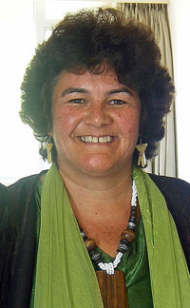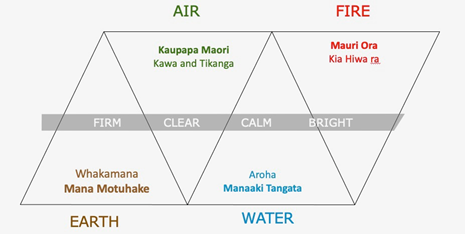Article: Masters in Applied
Indigenous Knowledge – Kataraina
Pipi
Introduction
This chapter focused on who I am, where I come from and key people and experiences that have shaped my thinking and practice.
This includes reference to TetraMap – a model, tool, framework and approach that has been part of Kataraina’s daily work and life for over 20 years, and she has shared with many people since. We are privileged to learn from her wisdom and grateful for the constant contributions she makes to the TetraMap whanau (family / community) .
Significant training and learning
 Publication in March 2021.advised
Publication in March 2021.advised
I invested five years studying Neuro Linguistic Programming (NLP) in the early 1990s. The topic fascinated me and it was like learning the English language all over again. The basis of NLP is a study of how people do what they do successfully and some of my favourite tried and tested models are those that I learned during my training.
I met and worked alongside Paraire Huata in the 1990’s and this added significantly to my journey learning about Māori models of practice and challenged me to think ‘Māori’; whakaaro Māori. This also changed my mode of delivery to a much more explicit Māori practice where my contribution to others was to utilise Māori models of practice such as Durie’s Whare Tapa Whā (a model of holistic wellbeing) and I was blessed to have been in Te Ngaru Learning Systems wānanga (learning forums) where I came to understand much more clearly the simplicity of working and living the Tapa Whā model.
In the late 1990’s I was invited by Paraire Huata to travel to Winnipeg alongside two other Māori women to look at the work of an Aboriginal Social Services agency called, ‘Ma Mawi Chi Itata’. It was there that I saw the PATH Planning tool. As a Facilitator, I am always on the lookout for new and different tools to support my facilitation work. I made contact with the creators of this tool and with their permission brought the tool back to Aotearoa and began using PATH as a tool for individual, whānau/hapū/iwi and organisational planning.
After completing this training, I was introduced to a New Zealand-grown tool called TetraMap which uses nature as a metaphor for understanding behaviour, appreciating different perspectives and providing a framework and approach for planning and development. I now train other Facilitators and use this tool in all of my work.
Another significant part of my learning occurred in 2003 when along with four other colleagues we completed the Post Graduate Diploma in Social Sector Research Evaluation with Massey University. I have worked as an independent evaluator/researcher with a particular interest in evaluating kaupapa Maori programmes and services since 2000.
I now introduce my Model of Understanding which is a result of critical reflection on my lived experiences and key learnings and forms the basis of my practice. I use TetraMap to assist in framing my reflections through a Māori lens.
Part B Model of Understanding
Introduction
This model uses TetraMap as a framework for the representation of this holistic model. TetraMap uses a universal metaphor of nature, and specifically the four elements of Earth, Air, Water and Fire. TetraMap helps us understand why we think, behave and see the world the way we do.
Figure 1: Model of Understanding

TetraMap as a behavioural model
The model is used in the context of understanding behavior. The four elements are described as follows:
 Earth – like a mountain is FIRM. This element is focused on results, are decisive, bold, direct, focused on facts and are action oriented. In Māori terms, this element exudes ‘Mahia te mahi!’, get on with the job, just do it! When this element gets under stress it gets blunt, so do not take it personally.
Earth – like a mountain is FIRM. This element is focused on results, are decisive, bold, direct, focused on facts and are action oriented. In Māori terms, this element exudes ‘Mahia te mahi!’, get on with the job, just do it! When this element gets under stress it gets blunt, so do not take it personally.
 Air – like the wind is CLEAR. Focused on quality, this element likes things to be logical and sequential, they like order, systems and processes, data and information. Quality and time are important to this element, time to consider, to plan and to ensure all is in place. In Māori terms, – ‘Kia tika te mahi!’ If you’re going to do a job, do it well. Under stress this element gets critical, because quality is at stake.
Air – like the wind is CLEAR. Focused on quality, this element likes things to be logical and sequential, they like order, systems and processes, data and information. Quality and time are important to this element, time to consider, to plan and to ensure all is in place. In Māori terms, – ‘Kia tika te mahi!’ If you’re going to do a job, do it well. Under stress this element gets critical, because quality is at stake.
 Water – like a lake is CALM. They operate from ngākau (heart) and puku (gut). Things must ‘feel right’. They are caring, considerate, loyal and patient, always watching out for others and in times of stress will sit on the fence, for fear of hurting others and will seem a little hesitant. In Māori terms – Kia ngākau māhaki! Operate from a place of peace, calm and humility.
Water – like a lake is CALM. They operate from ngākau (heart) and puku (gut). Things must ‘feel right’. They are caring, considerate, loyal and patient, always watching out for others and in times of stress will sit on the fence, for fear of hurting others and will seem a little hesitant. In Māori terms – Kia ngākau māhaki! Operate from a place of peace, calm and humility.
 Fire – like the sun is BRIGHT. This element is into the realm of possibilities. There is not one way to do things there are many ways to do things. They are full of ideas, spontaneous, think outside the square and are the eternal optimist. In Māori terms, this element reflects the notion of ‘Kia harikoa, me titiro whānui!’ Be happy and look beyond that which seems evident. In times of stress they are easily distracted.
Fire – like the sun is BRIGHT. This element is into the realm of possibilities. There is not one way to do things there are many ways to do things. They are full of ideas, spontaneous, think outside the square and are the eternal optimist. In Māori terms, this element reflects the notion of ‘Kia harikoa, me titiro whānui!’ Be happy and look beyond that which seems evident. In times of stress they are easily distracted.
TetraMap as a framework for understanding
Using TetraMap, as a framework for reflecting on my model of understanding, I will outline the model and use a waiata I composed, ‘Courageous Journey’ to illustrate key components of the model.
I have encapsulated the components based on four aspects that guide my practice: Mana Motuhake, Kaupapa Māori, Manaaki Tangata and Mauri Ora.
Mana Motuhake in this context speaks to my desire to support people to find and be their true authentic self, to be firm and steadfast in who they are and what matters to them. It sets a firm foundation for my practice as it is about affirmation and validation of Māori ways of knowing and being. In relation to working with people, it also encapsulates enhancing the mana (pride) in others. The vast majority of my lived experiences have been kaupapa oriented and revolved around supporting individuals, whānau-hapū-iwi and communities to affirm and realise their greatness. This is in essence is what Mana Motuhake is about and when this occurs it provides a firm foundation and builds on the legacy left to us by our ancestors.
Conclusion
This chapter focused on who I am, where I come from and key people and experiences that have shaped my thinking and practice. It has been an interesting reflective exercise to think about how my upbringing, schooling, employment, business endeavours and training have been significant pathways to my growth and personal development. My encounters with my grandparents and their teachings, my ‘coastal’ upbringing, my whānau experiences and exposure to a wide range of Māori endeavours have provided a rich tapestry of cultural metaphors.
In the next chapter, I will explore in more detail, three cultural principles that underpin my understanding and practice alongside literature to provide deeper insights into our ways of knowing and being.
